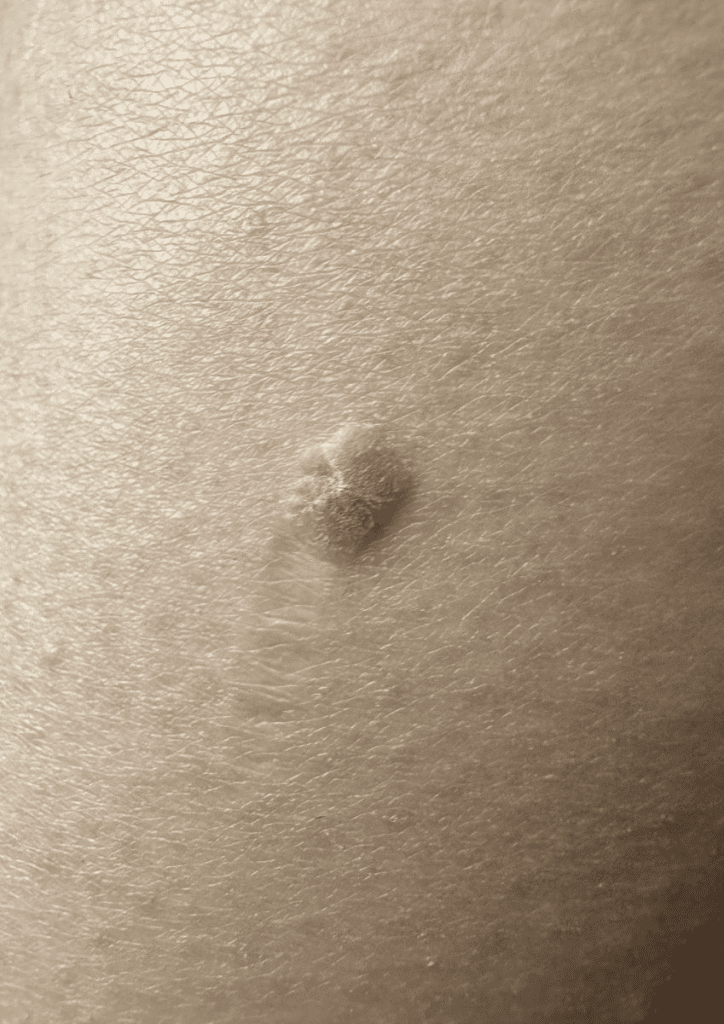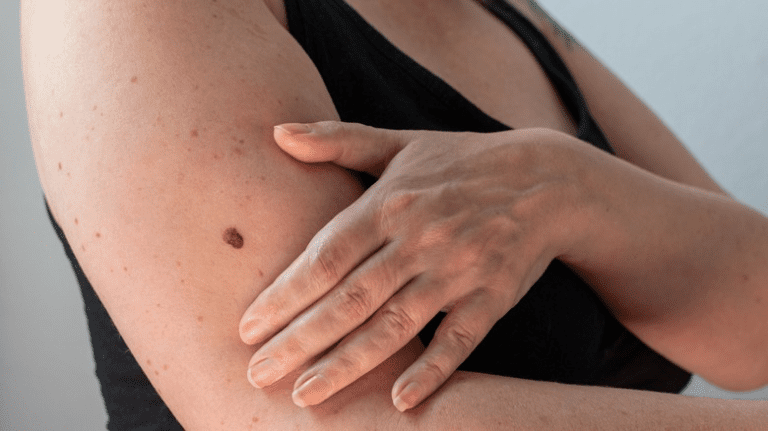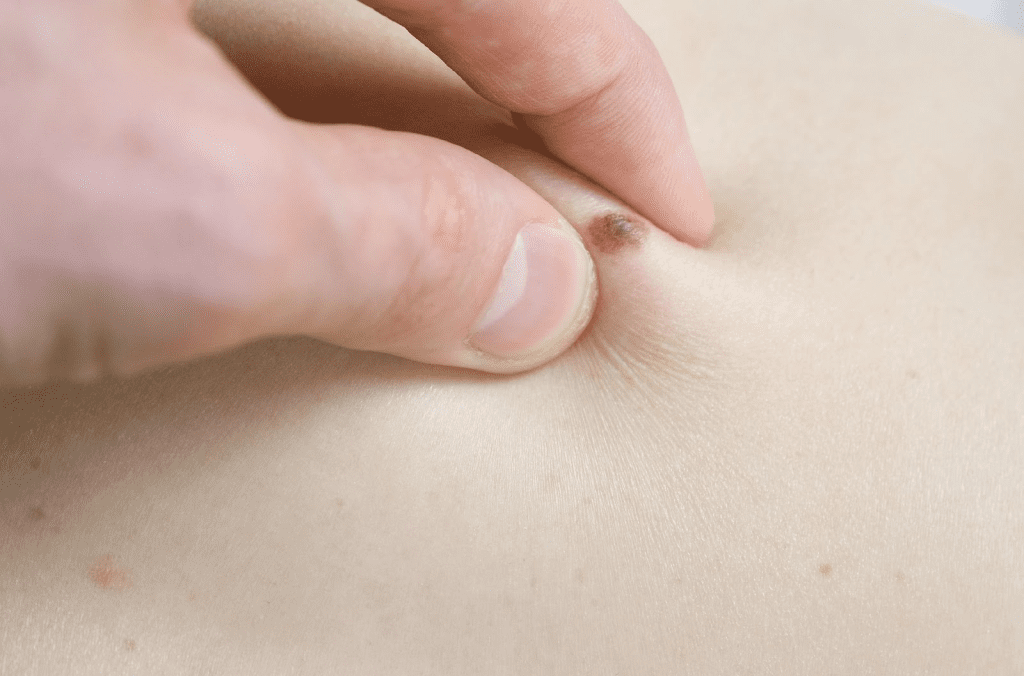Noticing changes in your skin can be unsettling, especially when it involves a mole that has become crusty or appears different from its usual appearance. While most moles are harmless, some changes could indicate more serious issues, such as skin cancer. Understanding when to be concerned and what steps to take if you notice changes in your moles is essential for maintaining your skin health.
Understanding Moles and Skin Changes

Moles are common and appear in most people. These small, pigmented spots on the skin are made up of melanocytes, which are the cells responsible for producing melanin, the pigment that gives skin its color. Most adults have between 10 to 40 moles, which can develop at birth, during childhood, or early adulthood.
For the most part, moles remain consistent in their appearance over time. However, it’s normal for moles to change slightly with age—sometimes becoming more raised or changing color. While these changes are often harmless, some alterations may signal more serious issues, such as melanoma, the deadliest form of skin cancer.
What Causes a Crusty Mole?
A crusty mole could be caused by several factors. Sometimes, moles can become irritated due to friction, dry skin, or sunburn. However, if the crusting is accompanied by other changes, such as itching, bleeding, or rapid growth, it could be a sign of something more concerning.
Melanoma, in its early stages, can sometimes manifest as a mole that changes texture or develops a crust. Therefore, it’s essential to monitor any changes closely and consult a healthcare provider if you notice anything unusual.
Signs to Watch For: The ABCDEs of Melanoma
One of the most effective ways to assess whether a mole may be cancerous is by following the ABCDE rule for melanoma. Each letter stands for a key feature to monitor when observing moles:
- A – Asymmetry: One half of the mole doesn’t match the other half. A healthy mole is generally symmetrical in shape.
- B – Border: The edges of a mole should be smooth and well-defined. If the borders are irregular, blurred, or ragged, this could be a cause for concern.
- C – Color: Healthy moles tend to have a uniform color. If your mole has multiple colors or shades, such as tan, brown, black, blue, white, or red, it might be time to get it checked.
- D – Diameter: Moles larger than 6mm (roughly the size of a pencil eraser) should be monitored more closely, especially if they continue to grow.
- E – Evolution: Any changes in size, shape, color, or texture, as well as new symptoms like bleeding, itching, or crusting, should be taken seriously. Moles that evolve over time warrant medical attention.
When Should You Seek Medical Advice?
If your mole exhibits any of the characteristics mentioned in the ABCDE rule, or if it becomes crusty, painful, or starts to bleed, it’s crucial to consult a dermatologist or healthcare professional. Even if a mole doesn’t show all the classic signs of melanoma, it’s always better to err on the side of caution.
Here are key moments when you should see a doctor about your mole:

- It changes in appearance: If you notice that your mole is changing in color, size, or texture, it’s time to have it evaluated.
- It starts to crust, itch, or bleed: These symptoms can sometimes indicate the presence of skin cancer.
- You have a family history of skin cancer: If skin cancer runs in your family, it’s important to be extra vigilant about any skin changes and schedule regular check-ups with a dermatologist.
A dermatologist may perform a biopsy, which involves removing a small sample of the mole to determine if it’s benign (non-cancerous) or malignant (cancerous). In some cases, the entire mole might be removed during the biopsy process if it’s suspected to be cancerous.
What to Expect During a Skin Check
Routine skin checks are one of the best ways to stay proactive about your skin health. If you visit a dermatologist, they will likely perform a thorough examination of your skin, looking for any suspicious moles or spots. Depending on your medical history and risk factors (like prolonged sun exposure or past sunburns), your doctor might recommend annual skin checks as a preventive measure.
For individuals with a history of skin cancer, more frequent check-ups may be necessary. Your dermatologist may also advise you on how to conduct self-exams at home, so you can monitor your skin between visits.
Why Early Detection Is Critical

The earlier skin cancer is detected, the more effective treatment tends to be. Melanoma, for instance, can spread to other parts of the body if not caught early, but when detected in its initial stages, it’s highly treatable. Regularly monitoring your skin and knowing when to seek medical advice can be lifesaving.
If caught early, many forms of skin cancer, including melanoma, can be treated through surgery or other medical interventions. However, once cancer has spread, treatment becomes more complex and challenging.
Preventing Skin Cancer: Tips for Healthy Skin
While monitoring your moles is essential, prevention is just as important. Here are a few tips to help reduce your risk of developing skin cancer:
- Wear sunscreen daily: Apply broad-spectrum sunscreen with at least SPF 30 to protect your skin from harmful UV rays.
- Avoid excessive sun exposure: Try to stay out of the sun during peak hours (usually 10 a.m. to 4 p.m.) and wear protective clothing, including hats and sunglasses.
- Avoid tanning beds: The UV radiation from tanning beds increases your risk of skin cancer significantly.
- Perform regular skin self-exams: Make it a habit to check your skin from head to toe at least once a month for any new or changing moles.
Conclusion
If you’ve noticed a crusty-looking mole on your thigh—or anywhere on your body—it’s essential not to ignore it. While many moles are harmless, changes in appearance, texture, or symptoms like itching or bleeding should be evaluated by a healthcare provider. Following the ABCDE guidelines can help you assess your moles and decide when to seek medical attention. Remember, early detection and treatment are crucial in preventing serious complications, especially when it comes to skin cancer.


